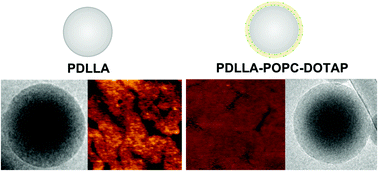Relevance of charges and polymer mechanical stiffness in the mechanism and kinetics of formation of liponanoparticles probed by the supported bilayer model approach†
Abstract
In specific conditions, co-incubation of polymer nanoparticles and phospholipid vesicles leads to the formation of lipid bilayer coated nanoparticles usable as biocompatible drug delivery systems for co-encapsulation of two drugs. In this work, we focused on the preparation and characterization of liponanoparticles obtained by co-incubation of poly(D,L, lactic acid) (PDLLA) and neutral (POPC) or cationic (POPC/DOTAP) liposomes. The comparison of the behavior of the various studied vesicles co-incubated with nanoparticles highlighted the role of electrostatic interactions. Although the bilayer adsorbed at the surface of polymer nanoparticles was not visible by cryoTEM, zeta-potential measurements and fluorescence confocal microscopy showed evidence of the formation of hybrid nanoparticles in the presence of cationic vesicles. Using silicon dioxide and Langmuir–Schaefer transferred polymer layer-coated surfaces, a thorough analysis of the process of formation of a phospholipid bilayer at the surface of a PDLLA film was performed by combining QCM-D and AFM experiments, taking into account the nature and properties of the support, and the concentration and charge of the lipids. Contrarily to POPC vesicles, cationic ones formed a bilayer on the PDLLA layer in water, but their fast rupture on the soft material did not allow complete nanoparticle surface coverage. This work demonstrates the role of charges and polymer mechanical stiffness in the mechanism and kinetics of formation of PDLLA liponanoparticles in pure water.



 Please wait while we load your content...
Please wait while we load your content...